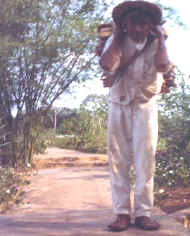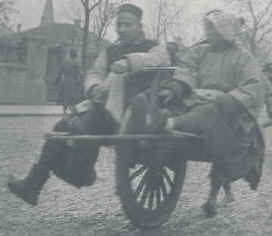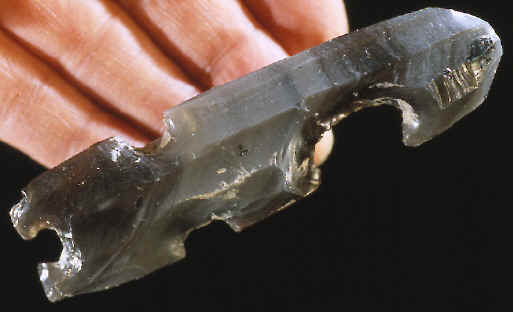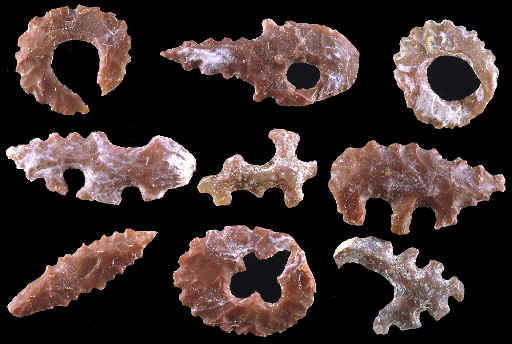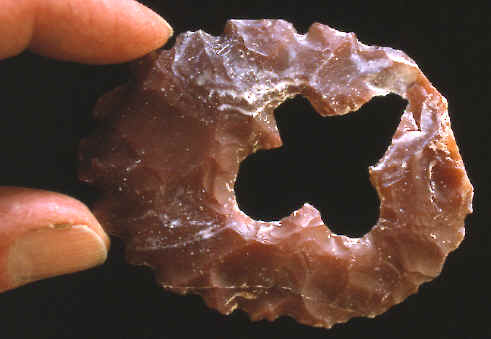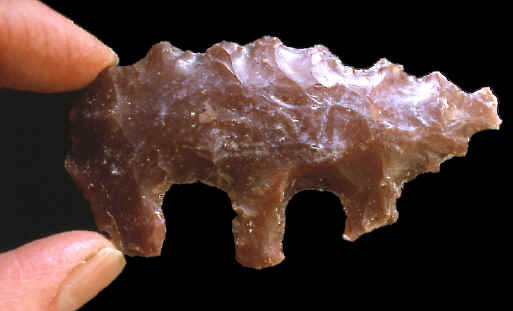|
|
|
The suggestion from some of the cache numbers of 9 and 13 is intriguing. Especially since there are 13 heaven gods and 9 underworld gods. Fash and Fasquelle remark in their 1991 National Geographic article about the Copan cache that "The nine we found may correspond to the nine divine Maya lords of the night." But a study done by Iannone (1992a: 252-253) determined that "eccentrics are usually found in groups, although no set number recurs often enough to be deemed significant." |
|
|
|
|
One of the largest Mayan eccentric caches ever discovered was found in 1998 during archaeological excavations of a pyramid at Piedras Negras, Guatemala. Houston (1998:1) writes "Almost immediately, workers struck one of the largest known caches in the Maya Lowlands, consisting of approximately 129 eccentrics." The cache contained 54 chert and 75 obsidian eccentrics. They are reported to have been in groupings of nine equivalent shapes. |
|
|
Some eccentric caches have been reported to have been "painted" with cinnabar. If you look at some of the enlarged images in this report you well see some red pigment adhering to the surface in small spots. It's interesting to note that cultures all around the world have been using red pigment in the form of red ochre to color ceremonial objects and burials. It fact, this practice dates to the days of the Neanderthals. The four sacred colors used by the Mayans on temples, pyramids and palaces are red, blue, yellow and green. |
|
|
|
|
Although there is a lot we don't know about Mayan eccentrics there is quite a lot of information that is accepted. At the top of the list is the fact that eccentrics were important votive offerings used by the Maya elite. They are almost always found within ceremonial confines on larger Maya sites in association with structures like pyramids, temples, altars and stelaes. Another accepted fact is that there are many different types of eccentrics but overall they have a typology that shows there is a standardization that exists and the designs are not random. Eccentrics date from the Late Preclassic or Formative Period from A.D. 150-250 to the Late Postclassic Period A.D. 1200-1400 but were in use most consistently during the Classic Period A.D. 250-900. Eccentrics were produced by craft specialists even though the flaking quality is quite variable. Also, their production centered in the Maya lowlands. |
|
|
|
|
Mayan eccentrics have fascinated archaeologists and the public for a long time. In the past, descriptions of eccentrics mainly focused on their archaeological context and lithic analysis, which is fairly considerable now. Recently, a new direction of study seems to be turning to the question of how the images they represent may have related to the world of the Maya elite. But without a Rosetta Stone to decipher them, all the mystery that surrounds their precise meaning will probably never be known. One thing is for sure though, Mayan "eccentric flints" will be studied for as long as there is a human curiosity and archaeologists to study them. |
|
|
"REFERENCES"
1946,
"The Ancient Maya," by Sylvanus G. Morley, page 436. |
|
